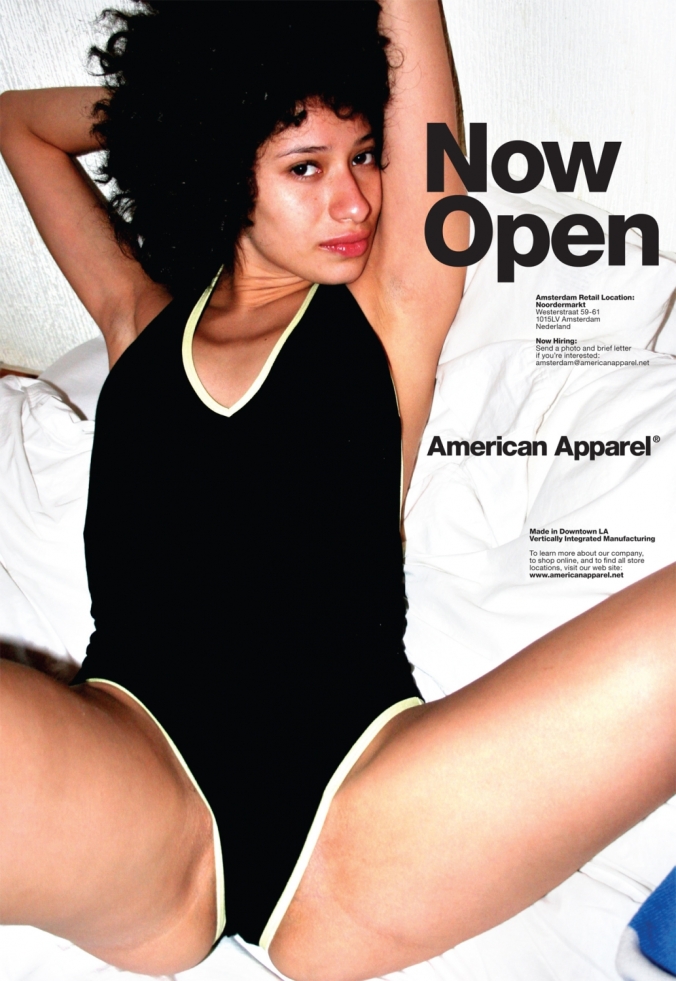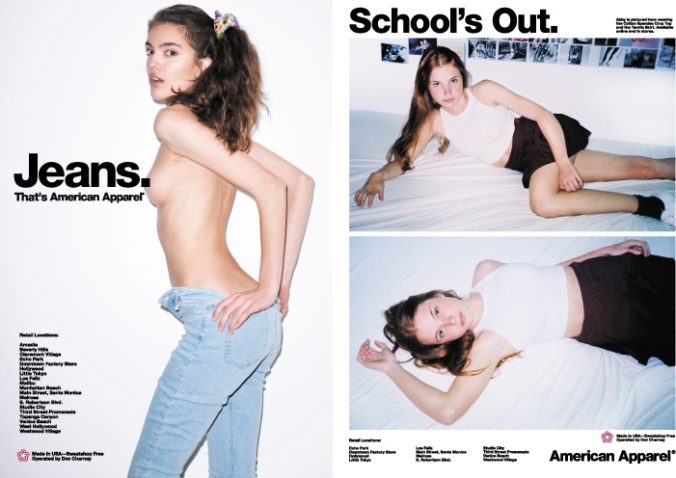Last November, American Apparel closed all the stores in Australia. The brand, which is known of sexual advertisement, announced bankruptcy at last.
Young girls and tempting expression, they are two key elements in their poster and advertisements. Such as this one below, the woman in the poster lying on the ground and spread her legs, looking at the audience directly. The words “Now open” stays in the right top corner. So what exactly is “open”?

Image 1 Now open
As a clothing brand, American Apparel focuses on human figure more then their clothes. Their designs are based on the 80th American pop culture. Honestly, their clothing are not that unique, even you can find similar product in any store on the street. But people will still buy their products. Should beauty be sexualized? Or should women play the roll of sexual to grab attention?
Cheryl Buckley mentioned: “Advertising serves to enforce the meaning of design as defined by the designer or manufacturer.”[1] In American Apparel’s advertisement, women are just like objects to attract the audience. They are natural, instead of hiring skinny and pretty young girls, the models are just like everyone else around us. “Advertising creates both ideal use for product and ideal user.”[2] In this advertisement below, the model is even half naked on the left poster. And on the right panel, the model lies on the bed, seems waiting someone. Words “School’s out” are right beside it. What does the poster try to express? The human figure or clothing? Beauty does not equal to sexual behavior.

Image 2 Jeans and School’s out
We cannot say the poster is a bad design. “Exclusive definitions of good and bad design are constructed, based almost entirely on esthetics. These definitions serve to isolate design products from material and ideological conditions of production and consumption”[3], said Cheryl Buckley. But female shouldn’t be defined as sex tools and relying on male. Although American Apparel declared that they are just using natural body to advertise, they are still be considered that trying to use sexualized poster to attract their customer, and it won’t last long. Some country even banned their advertisement for they think it will cause negative infection to their society. In contemporary society, women are not objects to show or grab attention, and sexual poster and advertisements will no longer be useful to attract customers. Designs should base on proper esthetic according to the contemporary society.
[1] Cheryl Buckley, ‘Made in Patriarchy: Toward a Feminist Analysis of Women and Design,’ in Design Discourse: History/Theory/Criticism, ed. Victor Margolin. Chicago and London: The University of Chicago Press, 1989, 251-62.
[2] ibid
[3] ibid
This is a really interesting point, American Apparel is so commonly seen and advertised that I had truly become desensitised to the female objectification of their marketing tactics. Your writing is blunt and to the point, which I really enjoy. Statements like “but what is really open?” definitely give your post some wonderful sass. However, it seems that this is the perfect opportunity to discuss ‘the gaze’ and how it is being used in these images. For example, the gaze of the subjects themselves is very strong, captivating, enticing; thus ensuring that the male gaze cast upon the image will be that of domination/superiority and pleasure. Overall, interesting stuff though!!
LikeLike
The undeniable connotations of sex in these ads are appalling and have honestly shocked me. I knew American Apparel had utilised sexual exploitation in their ad campaigns, but I never thought it would be this heavy. Especially in the first poster “Now Open”, the unease of her facial expression says it all. These marketers are more concerned with the pornographic appeal than the clothing itself by preying on the young minds of suggestable teenagers.
As mentioned in the previous comment, this would be a perfect opportunity to discuss the male gaze! I also disagree with your point about the models being “like everyone else around us”. They are undeniably “skinny pretty young girls” but they are dressed and styled to replicate societies ideal of the ‘sweet sixteen’ rather than the renown ‘runway model’. However, this does prove the point that as a society we are forced to accept and regard these bodies as the norm and not the exception. If we all looked like that we could all be models!
I think the issue is not with their clothing – as you said it’s much like any other (Supre etc.) – but with the marketing itself. Sex sells, but this has crossed the line.
LikeLike
Wow! I was shocked to see how sexualised American Apparels advertisements are but not that surprised to be honest. I feel like girls are just very over sexualised in today’s media even more so than before. Like the two previous comments I do agree that you could have talked a lot more about the gaze and further extended upon the objectification of women, but it was still written well and you made some very good points. I found the piece very interesting and insightful. Good job!
LikeLike
American apparel advertisement borderlines on immoral, with questionably aged models and grundy almost pornographic shots. Where do we draw the line? You talk about particular countries banning American Apparels advertisement as they fear the effect it may have in their society but doesn’t almost all fashion advertisement send a negative, unrealistic perspective on what one should look like? Does that means these countries should ban all advertisement? Where do we draw the line?
You also have a very interesting perspective on what you believe our contemporary society is becoming. You deem that in today’s world sexualising woman can not be defined as good design and further more, in the not to distant future, the sexualisation of woman will not have the same effect on their customer base as it once did. I have some thoughts on this:
Firstly, this idea that woman being used in a sexual context can’t be deemed good design, I believe is incorrect. Regardless of what you or I believe is good design and regardless of its aesthetic quality, if it works, if it achieves the goals outlined in the original brief then it must be considered good design. This is because it does what it set out to do, irrelevant of how it looks or what techniques it uses to achieve the objective, including the sexualisation of a gender.
Secondly, societies future is bleak. We are a consumer culture undoubtably. You state that as our society develops, the sexualisation of woman in advertisement will become redundant and ineffective on their audience. I just can’t see how this is possible. Making people feel inferior and then giving that person a ‘solution’ or a ‘chance’ to become like that model is an exceptionally effective selling technique. One might argue that the sexualisation of woman in the advertisement industry has started to become more self aware with more companies starting to push socially conscious, moral advertisements that embraces woman instead of exploiting them. But to that I ask, if we truely are stating to become more moral in our advertisement and we truely are heading in a new direction then why is it that the sexualisation of males in advertisement has become ever growing almost rampant in the last 10 years. This proves that we aren’t on the right track that cares about the way we view one another, we simply care about what sells best. If preserving woman’s rights sells better than sexualising them then that’s what we’ll advertise. But the second sexualising a male body sells better than embracing a positive male body image, that’s when we know we aren’t heading in the right direction, we’re heading in the direction we have always been, the direction of which ever option sells better.
LikeLike